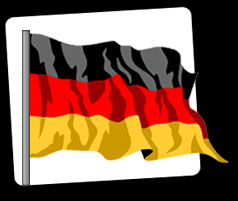Tracing the path of the Berlin Wall
 Berlin - Twenty years ago the Berlin Wall was the city's most distinguishing landmark. It extended for over 40 kilometres and was officially known by its East German builders as the "Anti-Fascist Defence Wall." Hardly anything remains to be seen of the wall today as most of its 45,000 concrete segments were dismantled and crushed in the years immediately after 1989.
Berlin - Twenty years ago the Berlin Wall was the city's most distinguishing landmark. It extended for over 40 kilometres and was officially known by its East German builders as the "Anti-Fascist Defence Wall." Hardly anything remains to be seen of the wall today as most of its 45,000 concrete segments were dismantled and crushed in the years immediately after 1989.
But in the year that marks the 20th anniversary since the fall of the wall ever increasing numbers of people are trying to retrace its path through the city and discover the last few remaining sections.
The Brandenburg Gate is a good place to begin. Today, hundreds of tourists pass freely through the gate which is a symbol of the city. During Berlin's division, however, the area around the gate was eerily quiet because the wall ran right in front of its columns.
Cobblestones embedded in the ground extend from the gate to Potsdamer Platz and mark the wall's path. Seven segments of the original wall can be found on the corner where a multi-storey office block now stands.
A man wearing the uniform of the former East German police, the Volkspolizei (People's Police), stands beside the segments offering tourists "original East German visa stamps." Pieces of chewing gum stick to a few of the segments and tourists have scratched their names into the concrete.
Despite the unusual setting the segments do give a good impression of how the wall marked the city, blocking streets and dividing Berlin in two.
That can also be seen at the nearby Martin-Gropius Bau arts museum. "The street in front of the building did not exist during the division of Berlin," explains Klaus Kowatsch who has been guiding visitors through the city since 1990. "Although the footpath was on the western side of the wall, it actually belonged to the east and could not be used by people in the west."
That explains why the entrance to the building's exhibition rooms had to be moved to the southern side. Not until the fall of the wall could the main entrance be re-opened to the public.
Right beside the Martin-Gropius Bau is the third longest section of wall that still remains standing. In the days immediately following the opening of the wall in 1989 thousands of people attempted to hack away its concrete. The wall beside the museum has been specially preserved to give visitors an impression of how it looked in those momentous days.
"It is no accident that the wall has been preserved on this spot," explains Kowatsch. This part of Berlin was once at the heart of the Nazi government apparatus. Immediately behind the wall are the grounds where the headquarters of the Gestapo, the SS and the Reich Main Security Office once stood. On the other side is the Reich Air Ministry building.
The former Checkpoint Charlie where foreigners and diplomats passed through the wall is a major tourist attraction. The allied forces' checkpoint hut was removed in 1990 but replaced later with a copy. Tourists can be seen at all hours of the day taking pictures of the structure. Many also use the opportunity to have a look at the House on Checkpoint Charlie museum.
The second longest section of wall to visit is on Bernauer Strasse. Following the wall's construction many people tried to flee the East by jumping to freedom from the windows of the houses that once stood here. Some leaped to their deaths in the process.
Further into former East Berlin can be found what is perhaps the best known section of wall: the 1.3-kilometre-long East Side Gallery. In 1990 artists from around the world painted the wall and those images can still be seen in restored form today. (dpa)